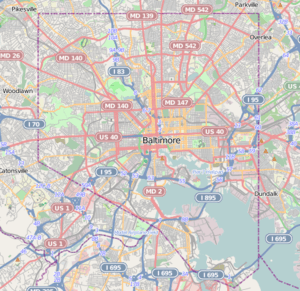Franklin Street Presbyterian Church and Parsonage
|
Franklin Street Presbyterian Church and Parsonage | |
|
Franklin Street Presbyterian Church, March 2012 | |
   | |
| Location | 100 W. Franklin St. (church), 504 Cathedral St. (parsonage), Baltimore, Maryland |
|---|---|
| Coordinates | 39°17′43″N 76°37′2″W / 39.29528°N 76.61722°WCoordinates: 39°17′43″N 76°37′2″W / 39.29528°N 76.61722°W |
| Area | 0.3 acres (0.12 ha) |
| Built | 1847 |
| Architect | Long, Robert Cary,Jr.; Andrews, Col. R. Snowden |
| Architectural style | Gothic Revival, Tudor Gothic Revival |
| NRHP Reference # | 71001036[1] |
| Added to NRHP | November 5, 1971 |
Franklin Street Presbyterian Church and Parsonage is a historic Presbyterian church located at 100 West Franklin Street at Cathedral Street, northwest corner in Baltimore, Maryland, United States. The church is a rectangular Tudor Gothic building dedicated in 1847, with an addition in 1865. The front features two 60 foot flanking octagonal towers are also crenelated and have louvered belfry openings and stained glass Gothic-arched windows. The parsonage has walls of brick, heavy Tudor-Gothic window hoods, and battlements atop the roof and was built in 1857. This church was incorporated in 1844 by a group of men from the First Presbyterian Church then located at the northwest corner of East Fayette Street and North Street (now Guilford Avenue) in downtown (later relocated in 1854 to West Madison Street and Park Avenue in Mount Vernon-Belvedere neighborhood after selling their previous third church building of 1790-95 to the Federal Government which built a U.S. Courthouse there [to 1889, replaced again 1932] dedicated in 1860 by President James Buchanan). They felt the need for a new church in that fast-growing northern section of the city formerly "Howard's Woods" of Col. John Eager Howard's (Revolutionary War commander of the famed "Maryland Line" regiment of the Continental Army) country estate "Belvedere" (mansion located at intersection of North Calvert and East Chase Streets, razed 1875) where the Washington Monument was erected with its four surrounding park squares just two blocks from their new building. Franklin Street Church was also located on "Cathedral Hill" in the southern part of the community bordering downtown and across the street from the old Baltimore Cathedral (Basilica of the National Shrine of the Assumption of the Blessed Virgin Mary) erected 1806-1821 and designed by Benjamin Latrobe. Later in 1882-1886, philanthropist Enoch Pratt founded his central library for the new Enoch Pratt Free Library then facing West Mulberry Street at Cathedral, a block south which was replaced in 1931-33 by a new central library building encompassing the entire block and now directly across Franklin Street from the F.S.P.C.[2] In 1973, the two historic congregations reunited to form The First and Franklin Street Presbyterian Church and was centered at the First Church site on West Madison and Park. The Franklin Street building was used by the merged congregation for a time and then sold to a fundamentalist independent Protestant congregation and later re-sold to the present "New Unity Church Ministries". Across Cathedral Street to the northeast was the 1820s era Greek Revival home designed by Robert Mills (who also did the Washington Monument two blocks away) which later was occupied by the original Maryland Club, an exclusive Southern-leaning dining and leisure society of gentlemen, founded 1857 that was once threatened by Massachusetts Militia Gen. Benjamin F. Butler, U.S.A. when he occupied Baltimore at the beginning of the Civil War on May 13, 1861, and fortified Federal Hill with a Fort and cannons overlooking the harbor and city, "to put a shot into it" if he spied a reputed rebel flag flying or any discontent to declared martial law. The Club later moved to North Charles and East Eager Streets in 1892 and mansion was later replaced by the former Central Building of the Young Men's Christian Association of Central Maryland (YMCA) which was closed in the 1980s and the building renovated as the Mount Vernon Hotel and Cafe.
The church is no longer used by a Presbyterian congregation and is currently occupied by the New Unity Baptist Church Ministries. John Gresham Machen, the founder of Westminster Seminary attended the church as a child.[1]
The church and parsonage were listed on the National Register of Historic Places on November 5, 1971.[1] They are included within the Cathedral Hill Historic District and the Baltimore National Heritage Area.[3]
See also
- First Presbyterian Church and Manse (Baltimore, Maryland), the reunited sister congregation, is also listed on the National Register of Historic Places
References
- 1 2 3 National Park Service (2010-07-09). "National Register Information System". National Register of Historic Places. National Park Service.
- ↑ Joseph Potts (November 1975). "National Register of Historic Places Registration: Franklin Street Presbyterian Church and Parsonage" (PDF). Maryland Historical Trust. Retrieved 2016-03-01.
- ↑ "Baltimore National Heritage Area Map" (PDF). City of Baltimore. Retrieved March 11, 2012.
External links
- Franklin Street Presbyterian Church and Parsonage, Baltimore City, including undated photo, at Maryland Historical Trust
- The First and Franklin Presbyterian Church website
- Presbyterian Historical Society; Philadelphia, Pennsylvania website - a part of the Presbyterian Church (U.S.A.) denomination]

